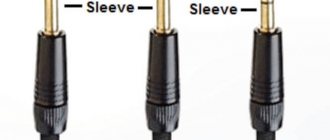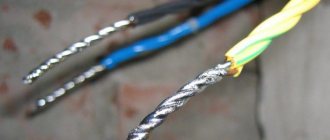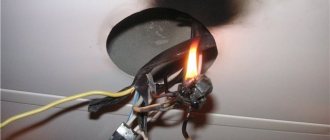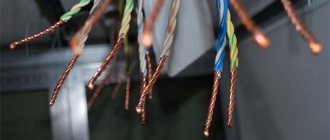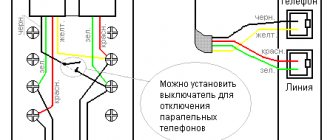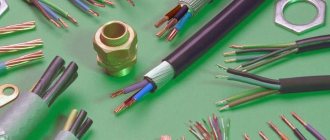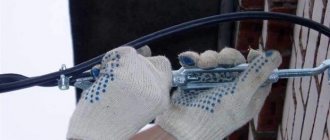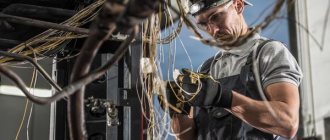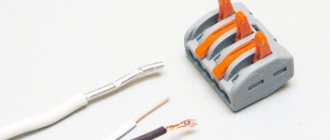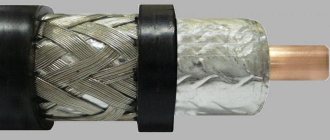- home
- Construction and renovation
- Electrics
>
>
⬎
When I need to connect copper wires in a junction box, I twist and solder them. However, at the moment there is a lot of debate about reliability: some claim that the soldered connection is the most reliable, while others criticize soldering and recommend spring terminal blocks. It is worth noting that the supporters of the soldering iron are experienced, Soviet-trained electricians.
Today we will not find out which is better - in my opinion, an objective assessment of the quality of connections will be a comparative test at extreme currents, perhaps in the future we will conduct a similar test. But now let's talk about how to twist wires in junction boxes and actually solder them.
I would like to note: despite the fact that the process is simple and easy to master, it must be performed with care and accuracy. After all, all fires, as a rule, are caused by poor contact in one place or another.
Advantages and disadvantages of soldering electrical wiring
A soldered connection is considered one of the best in terms of reliability.
In order to properly solder wires, you need to familiarize yourself with the advantages and disadvantages of the method. Despite existing analogues, this method is considered the most widespread and in demand, especially in electronics.
Advantages:
- Reliability. An important parameter is the presence and magnitude of the contact resistance. The lower it is, the better. For soldering, this parameter is extremely small. In terms of reliability, soldering is inferior to welding only in one case - if the work had to be performed in extreme conditions, for example, in an environment with extremely high or low temperatures, or exposure to aggressive environments. If we are talking about apartment wiring or a country house, such factors are excluded.
- The connection does not require maintenance.
- Versatility of use. With the help of soldering, it is possible to connect single-core and stranded wires with different cross-sectional areas, in any combination. This versatility allows you to solve many non-standard and difficult tasks. In addition, the use of fluxes ensures a reliable connection of copper and aluminum conductors.
- Low connection cost. To carry out the work you will need a soldering iron, solder and flux. The cost is low and the consumption is economical.
Flaws:
- Low technology. To carry out the work, it is necessary to carry out many preparatory measures, hence the high labor intensity.
- The need for performer qualifications.
When soldering, changes in materials occur at the molecular level, so the pre-soldered parts undergo thorough preparation.
What are distribution boxes for?
Rational wiring looks like this:
That is, the total energy consumption of the facility is evenly distributed among the circuit breakers. In addition, consumers should be divided into groups, for example:
- Living room and bedroom lighting
- Kitchen lighting
- Lighting for bathroom and hallway
- Socket group (in each room)
- Power socket group (for powerful consumers, such as an air conditioner or an electric oven)
But with such a scheme, there may be many connections on one wiring line. It is not safe to make overhead connections and hide them in the wall. At a minimum, this does not make it possible to disable a faulty branch while leaving the rest of the circuit operational.
For normal distribution of lines, there are distribution boxes.
They are an insulated container, inside which switching (permanent) of electrical wiring lines occurs. The connection of wires in a junction box can be done in various ways, the main thing is to ensure reliable insulation between phases and a contact that can withstand the load.
The wiring diagram in the junction box allows you to save money when purchasing electrical cables, as well as avoid uncontrolled interweaving of wires in the walls. The so-called radial wires diverge from the shield with protective circuit breakers. On each of them there are connecting nodes: those same distribution boxes.
Important: The wire cross-section may be the same or different. The main condition: the power of the main cable cannot be lower than the power of the final wiring to the consumer (socket, light fixture).
In addition, there are certain methods and rules for connecting wires in a junction box. Let's talk about this in more detail.
What you need to solder electrical wiring
Electric soldering iron
Before soldering the wire, prepare the working tool and consumables. To complete the work you will need the following list of tools:
- An ordinary household soldering iron, the power of which ranges from 40-100 W. As an analogue, a welding machine is used, on which it is possible to control the temperature of the tip, which simplifies the soldering process.
- A small file for cleaning the soldering iron tip.
- Knife for removing the insulating layer.
- Twisting pliers.
- Rosin intended for tinning surfaces.
- Solder for soldering different materials; acid-free fluxes are used as an analogue.
Gas torch Solder
Pine rosin for soldering
Soldering aluminum and copper wires differs somewhat in the types of solders used.
| Copper | Aluminum |
Tin and lead compounds are used. The markings are as follows:
|
|
A quick connection with big consequences
We often don’t think about the consequences of such a “simplification”. Meanwhile, an unreliable contact will fail at the most inopportune moment; the power supply to consumers/power receivers can always be cut off. Voltage “surges” cause breakdown of the elements of the power cascades of complex SBT household appliances. Even special protection devices used in the most “sophisticated” models of foreign manufacturers cannot save you from breakdown.
The induction of short electromagnetic pulses with a voltage of several thousand volts onto the electronic filling causes “harmless” sparking at the joints. At the same time, the standard protection equipment with which apartments are now equipped (RCDs, circuit breakers, fuses) do not “see” such short low-current pulses, so they simply do not trigger them, and we do not accept installing special devices for this. Uninterruptible power supplies for computers also did not become a panacea for transient impulses. The occurrence of “poke” causes malfunctions in the operation of electronic equipment and computer equipment, leading to failure of electrical components and expensive functional modules. Overheating at the site of a poor connection leads to even more catastrophic consequences; when current passes, the weakened connecting node becomes red-hot. This often causes fires and fires, causing enormous damage to the owners of the premises. Statistics show that 90% of all electrical wiring faults occur due to twists and poor contact connections of conductors. In turn, the very malfunction of electrical wiring and equipment, according to the Ministry of Emergency Situations, is the cause of one third of the fires that occur in Russia.
However, it so happened historically that several decades ago, in conditions of a shortage of electrical accessories/copper conductors, twisting aluminum wires was considered the main method used in electrical installation work. Twisting as a connection can be used in electrical engineering when carrying out repair and restoration work.
How to solder wires correctly
An example of universal sharpening of a soldering iron tip and proper maintenance of its working area.
The soldering process may differ slightly depending on the materials used. Different methods involve the use of different soldering compounds and fluxes. Most often, soldering of wires is carried out when connecting copper wires with a cross-sectional area of up to 6 mm2.
When performing work, follow the following algorithm:
- An insulating layer of approximately 5-6 cm in length is removed from the wires.
- Heat up the working tool and cover the surface with a layer of rosin or flux. The first one does not work well on oxidized surfaces; when penetrating deeply into the twist, it is important to thoroughly pre-treat the materials.
- When heating the wire using a heated tool with solder on the tip, it is important to achieve uniform distribution of solder over the entire surface being processed.
- When soldering twists, specialists must fill all irregularities with solder.
- Upon completion of the work, all twists are carefully insulated using special nozzles, electrical tape and heat-shrink tubing.
If you need to work with aluminum, it is important to take into account its high oxidation rate when in contact with oxygen. The resulting film does not allow for reliable adhesion of the metal to the solder.
Stripping wires of insulation
The oxide is removed mechanically, then the surface is serviced. The algorithm for connecting aluminum cores depends on the type of flux used and the cross-sectional area. A gas burner is usually used for heating.
The procedure for soldering cores with an area of 4-10 mm2:
- At the ends of cores 5-6 cm long, the insulating layer is removed.
- To obtain a metallic shine, the wires are cleaned with a file, sandpaper or a knife. Tinning of stranded wires
- The cores are connected to each other overlapping using a double twist method, and a groove is made at the point of contact in the middle.
- The joint is heated to a temperature that is close to the melting point of the solder joint.
- Each side of the twist is processed in a similar way, all cavities are filled with tin.
- At the end of the work, clean the connection area with gasoline.
- The cleaned surface is covered with asphalt varnish and carefully insulated.
The work is not fast, but the high quality and durability of the connections is worth the time and effort.
When is insulation needed?
When it so happens that there are a lot of thin wires on the board that are not isolated from each other, then insulating them is very desirable.
If during the repair of the power supply you replaced a couple of capacitors, then there will be nothing wrong if you leave the solder section without insulation after soldering.
Of course, if the power supply is not used in rooms with high humidity or outdoors.
When making homemade boards, the principle is the same.
Do you plan to use the device outdoors and don’t have thin, uninsulated wires? This means that solder protection on the board is not needed. Even regular rosin is enough. The main thing on homemade boards is the absence of metal debris and excess solder on the parts.
Another example during repair of a smartphone microphone. The microphone is soldered with only two wires to the board. Is solder insulation necessary? It is not advisable at all.
How to solder copper and aluminum wires
Soldering wires using the twisting method.
The copper wire is thoroughly cleaned, then immersed in rosin. A specialist melts a few drops of solder and, for tinning, the wire is immersed in the molten mass. The procedure is performed with careful and uniform movements.
Solder for soldering should cover the surface of the wire as little as possible. Excess is removed with a hot soldering iron. As the work progresses, the red tint of the copper wire should change to silver.
If the work is to be done with multi-core soldering irons, each wire should be untwisted and only then tinned. Then everything returns to its original position.
Before soldering electrical wires, the aluminum wire must be cleaned, and then the previously prepared flux must be evenly distributed over its surface. Next, the aluminum wire is thoroughly rubbed with a small piece of tinol and heated with the flame of a gas burner. Such manipulations will allow you to effectively get rid of the oxide film.
To increase the quality of connection of single-wire wires, twisting of tinned wires of small sizes is used. All resulting cavities are filled with tinol.
The next stage is connecting copper and aluminum wires. To do this, restore the insulating layer. For dry rooms, only cotton tape can be used.
Increased contact strength
Another example of why you need to cover the solder and the repair area with insulating material is to increase the contact strength. Usually, when repairing connectors or cables, a radical option for strengthening the contact is used. It's a mixture of baking soda and superglue. You can also use a compound that hardens with hot air and epoxy resin.
Such methods are used only to strengthen contact when fastening points, part of the board are missing, or there is serious damage to the part.
When a torn cable is repaired, it can also be further strengthened with a solution of soda and superglue. But be careful and careful with this method - superglue and epoxy resin eat into the surface of the material, and it will not be possible to remove them later for repeated repairs.
Recommendations, precautions
Professional soldering iron DANIU 110V/220V 60W with temperature control and a set of tools.
You should familiarize yourself with the recommendations that will allow you to perform the assigned tasks efficiently:
- When choosing a soldering iron, you need to pay attention to models equipped with additional cones, needles and a set of replaceable tips.
- Before you begin soldering, you need to pay special attention to cleaning the tip. If the tip is too dirty, remove all dirt using a soldering iron. You can use pieces of wood or cardboard as an aid.
- When changing the length of the soldering iron, the heating temperature of the tool also changes.
- It is not recommended to leave the soldering iron “dry” while heating the working element. The tip needs to be dipped into rosin regularly.
It is important to take precautions. You need to work in personal protective equipment: special clothing (overalls), goggles and gloves. Do not leave exposed areas of the body, otherwise severe burns may occur.
Twist
The simplest and most common way to connect wires is ordinary twisting.
For this type of connection, all the equipment required is a knife for stripping the insulation and pliers to ensure a reliable connection. However, at the end, the place of twisting will need to be insulated.
Twisting is done in several ways.
The simplest is mutual twisting of the stripped ends of the wiring.
For reliability, it is advisable to expose the wires by at least 5 cm. Next, the exposed ends are crossed so that the edges of the insulation touch, and then the crosshairs of the wires are grabbed with the jaws of pliers and twisted with a rotational motion.
After twisting, the connection is bent to one side so that the twist lies parallel to the wire. The connection is then isolated.
The second method is also effective and simple twisting.
The stripped ends of the wires are slightly bent in the middle, and at the bend the wires engage with each other.
After the end of one wire is wrapped around the second, the same is done with the other end of the wiring.
For reliability, the made windings can be slightly tightened with pliers. Then everything is isolated.
The next method is a bandage connection. For such twisting you will need a piece of stripped wire.
The two wires to be connected are placed parallel to each other so that the stripped ends touch along the entire length.
Then they are wrapped with the available piece, creating a kind of bandage.
The last of the used twisting methods that you can find is groove twisting.
To do this, small hooks are made from the ends of the wires, which are interconnected, and then one edge of the wire is wound around the other.
More complex types of wire connections are presented below.
Now about ways to isolate twists.
Often, different types of electrical tape are used for insulation. When using it, you need to wrap not only the place of twisting, it should extend at least 2-3 cm onto the wire insulation.
